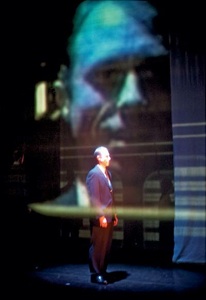Colin Wilson: Bananas
I’ve just had the terrible misfortune to read Colin Wilson’s memoir and analysis of the Angry Young Men: The Angry Years
(Robson, 2007). I read it because that era - Look Back in Anger and so
on - was a great research interest on mine and while I don’t publish
much on it now I like to keep up with what’s being published in that
area. Colin Wilson was one of the key figures in that movement; his
book, The Outsider was published within days of the opening of Look Back in Anger
and the two men were grouped together, alongside other figures like
Kingsley Amis, John Braine, John Wain and others, as figures in the
vanguard of a literary dissatisfaction with the current world. It’s a
movement that, in cultural terms, can fairly be regarded as having
presaged the artistic explosions of the 1960s.
The subtitle of Colin Wilson’s book is
‘The Rise and Fall of the Angry Young Men’ and Wilson rose and fall more
steeply and quickly than most. The Outsider was
acclaimed on publication by some leading critics and became a surprise
best-seller - surprise, because the book is a dense work of
quasi-philosophical commentary, thick with quotations from Sartre,
Camus, Hesse, Dostoevsky, Nietzsche and others. He was acclaimed, feted,
became a figure in the gossip columns, not merely on the literary
pages. But this turned to farce when his girlfriend’s father turned up
unannounced, horsewhip in hand, to break up their relationship. Further
tabloid skirmishes and controversies ensued - Wilson was goaded into
making some ridiculous remarks (not mentioned in this volume) and his
friends and associates, particularly the disgusting neo-Nazi Bill
Hopkins, revealed themselves to be low-talent semi-fascists. When his
next book appeared, Religion and the Rebel
(1957), it was utterly destroyed by the critics. His moment in the sun
was over. But doggedly he continued writing with an increasing interest
in esoterica: alien landings, true crime, the paranormal, studies of
spiritual thinkers like Gurdjieff, Jung, Ouspensky and others. There
have been novels too. He has written over a hundred books.
Okay, let’s start with what’s good.
Well, it’s good to have a record of the period from the point of view of
one of its lesser but still important figures. There are some
interesting insights into the cultural flows that link Paris and London.
He paints a particular picture of the quasi-commune at 25 Chepstow
Villas, where he and his little Hitlers hung out ruminating on their
superiority to the rest of us. He anecdotalises interestingly on his
encounters with some other Angries. I was intrigued by Wilson when I
wrote my book on the period. He seemed to be someone who represented a
defiant continentalism and intellectualism that was counter to the
Anglo-anti-intellectualism of Osborne and others.
Wilson’s view of the era is that the
whole ‘Angry Young Men’ phenomenon was a media fad that debased everyone
involved, misrepresented some (Wilson & Co.) and overpromoted the
rest (everyone else). He makes this distinction overtly and covertly;
the ones he like are ‘thinkers’, and are usually extremely - and I mean
extremely - right wing. Bill Hopkins, whose first and only novel, The Divine and the Decay,
told an approving story of Nietzschean overcoming focusing on the
leader of a quasi-fascist political party. And ‘thinker’ is a term that
Wilson seems to think applies indifferently to philosophers and artists;
he judges everyone on the quality of their thought. He has absolutely
no sense of artistic value and certainly doesn’t comprehend the idea
that artistic complexity might embody thought. This leads him to some
startling judgments. You have to pity someone who thinks Chekhov,
Osborne and Beckett are bad playwrights, but has bags of time for Ronald
Duncan and Nigel Dennis.
The book is unintentionally funny in
places, where he reveals a love for the pedantic detail and the
small-minded observation. His dinky little psychologising dismissals of
people endlessly smarter and more talented than him are priceless
entertainment. The flat sentences are relentless in their weird,
uninteresting detail (‘As soon as his book, Crowds and Power, came out in 1962, I bought a copy’, ‘a letter from her of 13 May - a fortnight before publication of The Outsider
- refers to Chepstow Villas and mentions that “I much enjoyed that
evening with you and Bill”, an occasion I have forgotten’). But it
becomes worse than that. Ultimately the book becomes a portrait of a
deeply unpleasant person.
Secured in his Dorset retreat, he is
able to make astonishingly Olympian judgments about thinkers like Sartre
and Camus, so vastly his superior that it seems peculiar that he should
occupy the same sentence as them. But no, in the epilogue he corrects
Sartre on a couple of matters; oh and then reads a biography to explain
why Sartre made this elementary mistake. Indeed throughout the book,
Wilson has a strange and increasingly horrifying habit of explaining
away entire oeuvres by reference to people’s personal shortcomings.
Tynan is ultimately just his spanking; Amis his promiscuity; Braine his
drinking; Trocchi his syringe. These things were important to these
lives but for Wilson their work can be uncomplicatedly reduced to them.
It suggests someone with a chip on his
shoulder and this is revealed in time. His problem is that he has never
really studied philosophy; he’s read it but without anyone to challenge
and extend his reading, help him to really formalise and test his ideas.
In the book he is quite defensive about not having been to university -
‘since I had spent the past ten years or so educating myself, the idea
seemed pointless’ he declares. Now, I don’t think everyone needs to go
to university, but Colin Wilson suffers badly from the pitfalls of the
autodidact; he only knows what he knows and seems to have gained
absolutely no understanding from the thousands of books he’s read. He
reads voraciously, indifferently, ignorantly - and driven, it seems to
me, entirely by prejudice.
When he condescends to read the novels or the plays (and he usually only reads
plays), he dispenses dull, mid-century opinions. The first act is too
long. The central character is too passive. Oh dear, oh dear, the ending
is a little implausible. It’s like Pooter’s been put in charge of the Times Literary Supplement.
The truth is that his aesthetic tastes and his philosophical beliefs
were formed amateurishly in the early fifties and he hasn’t moved on.
His account of European philosophy after Sartre would be flatteringly
described as ‘sketchy’. His psychological vocabulary - everyone
is psychologised by this stupid little man - is full of defunct
terminology like ‘alter-ego’ ‘domination’ ‘the psychology of the Right
Man’ ‘introversion’, the unmistakeable psychobabble of the 1950s. He
quotes the people he read as a young man and hasn’t read any more.
(Anyone with the slightest interest in the
contemporary world would hesitate before referring to black people as
‘coloured’.) He subscribes to a laughable creed about sex: creative
people, he insists, have a particularly vigorous view of sex as
self-fulfilment and cannot be tied down to a single partner. He leers at
other people’s sexual histories in a mixture of envy and contempt. He
is clearly freaked out by homosexuality. In other books, Wilson has
revealed himself as a panty-fetishist but here he vicariously presents
himself as the grand Marquis de Sade. Vicariously, of course: he’s much
too pusillanimous to discuss his own casual fucks.
Most appallingly, he justifies himself
by gloating over the decline of his peers. Oh he pretends the opposite
(claiming to experience ‘a feeling of sadness as I contemplate the
wreckage of so many of my contemporaries scattered over the literary
battlefield’), but he’s lying. His discussion of his rivals (he refers
to them as rivals - and that ‘battlefield’ metaphor is instructive) is
unmistakeably gleeful. He reels off a gossipy, partial view of Tynan’s
misfortunes. He leers over Osborne’s failed marriages. He tut-tuts about
Braine’s alcoholism and his sneers over Amis’s impotence. But what did
you achieve, one is tempted to ask? Wilson scorns the fad of the Angry
Young Men, but without that media fad you’d not even have published your
tawdry Encyclopedias of Murder and idiotic accounts of alien abduction
tales. You never deserved fame and this book demonstrates it. You can’t
write. You can’t think. And you can’t feel.
Indeed, ironically, this would-be Nietzschean Overman actually reveals himself to be consumed with Nietzschean ressentiment. In The Genealogy of Morals,
Nietzsche writes that the powerless only achieve dominion over the
Overmen by turning their puny resentment into a grand moral system that
reins in their superiors. I’m no Nietzschean, but it’s hard not to think
of this as, time and again, Wilson aims his philosophical pinpricks at
finer stylists, better thinkers, more successful writers.
One of the key moments of Colin Wilson’s
downfall was a very damaging review that pointed out that for all his
supposed reading and thinking, The Outsider
was full of misquotations and other errors. He’s not changed. This is a
terribly sloppy book. Some of the errors are no doubt slips of the
finger (‘Irish Murdoch’ anyone?) and some are failures of memory (he
writes ‘Bellecqua’ for ‘Bellacqua’) but the largest error is, of course,
his ignorance that seeps through the book, turning everything complex
into the simple, wrong thing.
Towards the end of the book, he refers to Sartre’s concept of ‘magical thinking’: ‘in which people convince themselves of a piece of wishful thinking which they know to be untrue; clearly it is a mild form of insanity’. He uses this as a stick to beat Tynan. But it is more evidently true of Wilson, the man who announced himself a genius in 1956 and has continued to believe it, despite all evidence to the contrary. A nasty little book by a nasty little man.





![photo[1].jpg](https://images.squarespace-cdn.com/content/v1/513c543ce4b0abff73bc0a82/1362919072201-PZO854G4SEB794DVOEI8/photo%5B1%5D.jpg)
